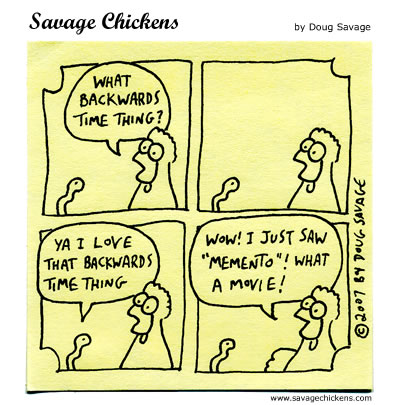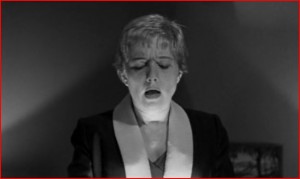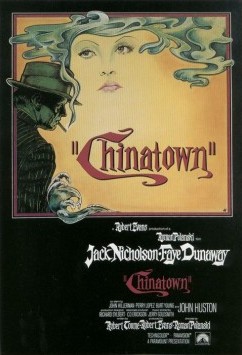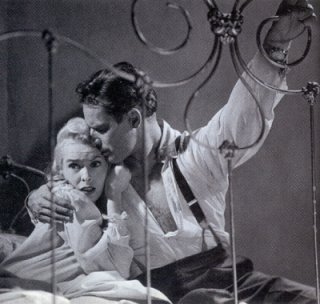On Dawn of the Dead fan site dawnofthedead.net, there’s a page where the author gives his or her reflections about the movie. It’s not very long or even very detailed but I think it does capture the movie’s allure pretty well nonetheless. The lines “Every time I see Dawn of the Dead, I get this strange sense of wonder, mystery, excitement” and “sparks my desire to be in ‘The Land of the Dead’” in particular sum up why people have taken to the movie as much as they have. Above all else, it makes you want to be right there with the characters in this situation.
A good chunk of what we see really does seem like it’d be quite a bit of fun to experience. Much of that has to do with the fact that they’ve decided to hole up in a shopping mall. It’s not only the variety of goods inside that we all covet, though, but also what the mall represents here – a relatively safe heaven. The mall makes the scenario they face manageable, even comfortable. They can secure the entrances with trucks and lock doors which feature alarms and glass that’s tough to break. They’ve even come upon an area hidden from the rest of the mall to reside. And everything they need is located in all the stores throughout.
Then there’s the element Professor Gershovich discussed in class Thursday. When there’s a mass disaster like this, it sort of gives everyone a sense of agency that they didn’t have before. The organizational structures and procedures that had to be abided by before become obsolete. Under these circumstances, anything goes. Everything’s up to them and they may do as they please. There’s something exhilarating about that. Especially given that they’ve secured themselves in a mall, there’s no longer an obligation to do work of any kind either. These people are completely freed of those mundane, monotonous obligations that weigh us down in every day life.
So, instead, what they initially get is a series of adventures (to secure the mall) and I’d again emphasize that it’s a manageable one. These are excruciatingly slow zombies. Only when something especially stupid is done (Roger forgetting his bag and then dropping it, Steven struggling to get the keys off his belt, Fran being left alone without a gun) is there any real danger. They also get to pick off these zombies like target practice, as if it was a video game. And after they finally clear out the zombies, they play actual video games and skate and treat themselves to the many other luxuries the mall has to offer. This is also lots of fun to watch.
But around the last quarter of the film or so, reality sets in and the tone drastically shifts. That allure fades and you realize this may not be a scenario you want to be stuck in after all. As discussed in the incredibly thorough and fascinating article by Stephen Harper entitled “Zombies, Malls, and the Consumerism Debate: George Romero’s Dawn of the Dead” (which can be found at americanpopularculture.com/journal/articles/fall_2002/harper.htm), the scene in which we see that Fran, who earlier in the film referred to the mall as being “so bright and neatly wrapped, you don’t see that it’s a prison too,” has fallen into the trap herself is especially powerful. It really sort of cements the idea of consumerism being such a negative thing. She has dolled herself up immensely and become, as Harper puts it, “a human zombie no more alive than the conspicuous mannequin heads on which the camera mockingly alights.” To really hammer the point home, as we’re shown this, there’s even a recording over the mall loudspeaker which hopes to manipulate customers into consuming and consuming now (spend $5 in next half hour, get free bag of hard candies!). 
It’s important to note, however, that this comes shortly after two more key scenes. First, during that dinner Peter arranges for them, Stephen offers to marry Fran only to be rebuked with “it wouldn’t be real”. A minute or so later, we see the two in bed staring ahead blankly. Fran only fully dives into commodity fetishism once we see that she’s seemingly been rendered hollow inside or at least perceives what they’ve set up as being empty and meaningless. So maybe our so-called “zombification” begins before the consumption and not necessarily as a result of it. This mindless spending is more a byproduct of our environment as a way to compensate for what’s missing.
 The fabric of society has been destroyed and things around them have become very stale. Stephen keeps turning to the television with the hope that broadcasts will resume and there’ll be some sign of life. But when they finally do come into contact with other people, they come in the form of a violent, reckless gang of bikers. That brings me to the ending, which seemed tacked on and out of place to me. After reading about what they initially had planned, I’ve grown even more disappointed. Originally, Peter was supposed to shoot himself and Fran was meant to put her head in the helicopter’s blades, also killing herself. Frankly, I would’ve loved that. Not only did it feel like most of the final 30-40 minutes were building toward something like this but I think it’s also far more interesting to ponder than the one we actually got. It would’ve further called into question exactly what makes life worth living. Below is the test shot of what would’ve been Fran’s demise released by Tom Savini, who worked on the film’s special effects. What are everyone else’s thoughts on this?
The fabric of society has been destroyed and things around them have become very stale. Stephen keeps turning to the television with the hope that broadcasts will resume and there’ll be some sign of life. But when they finally do come into contact with other people, they come in the form of a violent, reckless gang of bikers. That brings me to the ending, which seemed tacked on and out of place to me. After reading about what they initially had planned, I’ve grown even more disappointed. Originally, Peter was supposed to shoot himself and Fran was meant to put her head in the helicopter’s blades, also killing herself. Frankly, I would’ve loved that. Not only did it feel like most of the final 30-40 minutes were building toward something like this but I think it’s also far more interesting to ponder than the one we actually got. It would’ve further called into question exactly what makes life worth living. Below is the test shot of what would’ve been Fran’s demise released by Tom Savini, who worked on the film’s special effects. What are everyone else’s thoughts on this?





































 speak of, a subject that was taboo in any social setting. It was thought of as a topic that would corrupt society and therefore limitations were placed on what film producers could and couldn’t do when depicting relationships. Married couples were often shown sleeping on different beds, and any implications of sex were considered scandalous. Scenes such as that in Double Indemnity where Phyllis come out covered only in a blanket, or the scene ended shortly after a kiss which leave the rest to the audiences imagination were seen as pushing the limit. In the film noir films we have viewed in class anybody having a relationship with a woman can almost certainly be expected to die. This holds true whether the women is a femme fatal as Phyllis in Double Indemnity, Gilda in Gilda, and Elsa from Lady from shanghai or a wholesome woman such as Polly from D.O.A. Men who fall for these women all end up dead or in a non idealistic situation. I believe that by doing this the intended message to the audience is that women and relationships will lead to your downfall. Movies such as these are meant to promote purity, because of the fear that sex will corrupt the minds of society. Although the portrayal of sex in films has come a long way from the film noir period the fear of sex and portrayal of sex as negative is still visible today. Modern films will show acts of sex but they do so in a way that still carries on the message th
speak of, a subject that was taboo in any social setting. It was thought of as a topic that would corrupt society and therefore limitations were placed on what film producers could and couldn’t do when depicting relationships. Married couples were often shown sleeping on different beds, and any implications of sex were considered scandalous. Scenes such as that in Double Indemnity where Phyllis come out covered only in a blanket, or the scene ended shortly after a kiss which leave the rest to the audiences imagination were seen as pushing the limit. In the film noir films we have viewed in class anybody having a relationship with a woman can almost certainly be expected to die. This holds true whether the women is a femme fatal as Phyllis in Double Indemnity, Gilda in Gilda, and Elsa from Lady from shanghai or a wholesome woman such as Polly from D.O.A. Men who fall for these women all end up dead or in a non idealistic situation. I believe that by doing this the intended message to the audience is that women and relationships will lead to your downfall. Movies such as these are meant to promote purity, because of the fear that sex will corrupt the minds of society. Although the portrayal of sex in films has come a long way from the film noir period the fear of sex and portrayal of sex as negative is still visible today. Modern films will show acts of sex but they do so in a way that still carries on the message th at sex and relationships will lead to your down fall. In most horror films those shown having sex will die shortly after, the typical lone survivor will be the virgin of the group. A perfect example of this would be Friday the 13th (2009) where basically everyone dies in aright before, during, or after committing a sexual act. This theme of the virgin surviving exposes Americas still existent fear of sex. Although I do not have a problem with the production of films today I find it interesting how America projects sex in films as negative but allow other things which may have a greater impact on society such as crime and violence. I believe violence in movies is something that also has a great chance of corrupting the minds I would say even greater then sex and find it interesting that America has never made as big a deal about it.
at sex and relationships will lead to your down fall. In most horror films those shown having sex will die shortly after, the typical lone survivor will be the virgin of the group. A perfect example of this would be Friday the 13th (2009) where basically everyone dies in aright before, during, or after committing a sexual act. This theme of the virgin surviving exposes Americas still existent fear of sex. Although I do not have a problem with the production of films today I find it interesting how America projects sex in films as negative but allow other things which may have a greater impact on society such as crime and violence. I believe violence in movies is something that also has a great chance of corrupting the minds I would say even greater then sex and find it interesting that America has never made as big a deal about it.
 In Kiss Me Deadly, almost all who sought to retrieve the case ended up dead. Mike Hammer only survived after realizing that its contents are more serious than he could handle alone, and that he should hand it over to the police, thereby ending his desire for the box. While the contents of the case are never revealed, it is assumed to be a kind of dangerous atomic energy. Released during the Cold War, this movie is an example of the public’s general fear of a nuclear apocalypse.
In Kiss Me Deadly, almost all who sought to retrieve the case ended up dead. Mike Hammer only survived after realizing that its contents are more serious than he could handle alone, and that he should hand it over to the police, thereby ending his desire for the box. While the contents of the case are never revealed, it is assumed to be a kind of dangerous atomic energy. Released during the Cold War, this movie is an example of the public’s general fear of a nuclear apocalypse.
 There are several ways to watch
There are several ways to watch 


